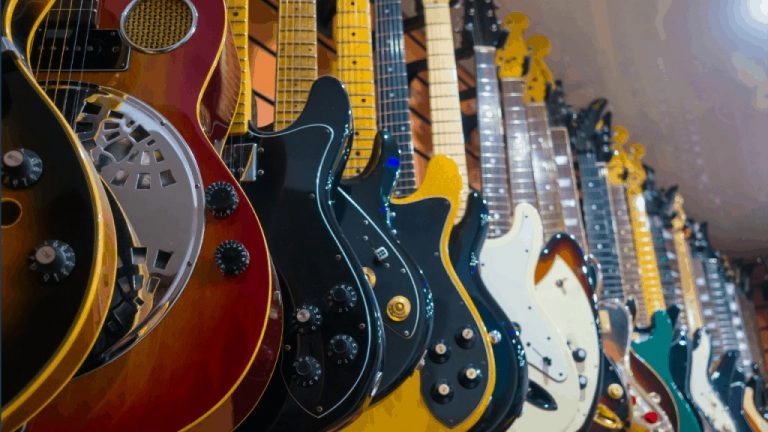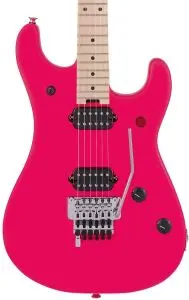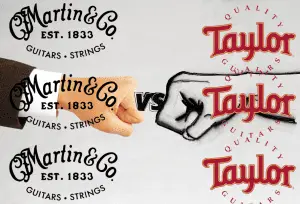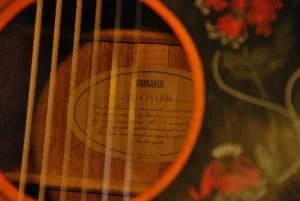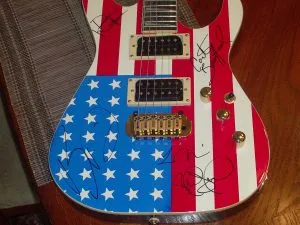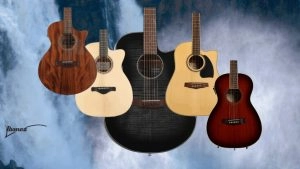If you’re in a hurry and want to cut to the chase, know that we recommend the PRS SE Custom 24 as the best electric guitar under $1,000. You can check its price on Sweetwater here.
Are you an intermediate guitarist looking for your first non-beginner axe?
Or are you a pro looking for a reliable workhorse electric guitar?
Either way, you’ll find a guitar that suits you in this price range.
Here are what we think are the best electric guitars under $1,000 out there:
Epiphone Limited Edition 1959 Les Paul Standard
Best Starter Les Paul
Best Well Rounded Yamaha, AKA Best Superstrat Under $1,000
Charvel Pro-Mod So-Cal Style 2 24 HT HH
Best Complex Tone Tele
Ibanez Genesis Collection RG550
Best Guitar Under $1,000 that Talks Dirty to Me
Sterling By Music Man Mariposa
Best Combination of Action and Styling under 1,000
• • •
Best electric Guitars Under $1,000 — My Picks
With interest rates rising and inflation posing a real pickle for just about everyone on the planet, choosing the right option among the best guitars under $1,000 becomes an ever more serious question. After all, $1,000 is a lot of money, so we want to bring you the best electric guitars for your limited resources. Let’s dive in.
Fender Player Stratocaster – For Fender Acolytes
Since 2018, the Player Stratocaster has been Fender’s default entry-level Strat.

That year, the Player replaced the Standard Series Stratocaster.
Like its predecessor, the Player is made in Mexico. But it features several significant improvements.
Perhaps the Player’s most important upgrade is its pickups, featuring Alnico magnets.
In the words of Justin Norvell, Senior Vice President of Fender Products,
“The Standard models had slightly hot and dark ceramic bar magnet pickups that we felt didn’t bring out all the nuance, personality, and clarity that a Fender is known for, but they did perform well with higher gain sounds,” explains Norvell.
Therefore, we knew we wanted to step up to a more complex alnico pickup while also retaining some hotness and output, so we went with alnico Vs on most guitars, and a few have IIs. We went through several months of shooting out pickups and probably a dozen sets until we were happy.”
Also, while the old Standard Series Stratocaster had a 6-point bridge, the Player has a 2-point tremolo — like what you’d find on an expensive, real-deal American Strat.
- You’ll get the iconic Fender American Stratocaster sound for a fraction of the price. There’s not much of a difference between the two guitars, and you can always upgrade later.
- Other cool features include:
- Dedicated tone control for the bridge pickup allows fine-tuning your sound in pickup positions one and two.
- The Player Strat is a versatile instrument. But it’s probably not the best fit for thrash and similar extreme-metal styles.
Besides the classic S-S-S arrangement, the Player Strat comes in H-S-S and H-S-H variations. At least one of them will strike your fancy regardless of your favorite musical genre.
Oh, and if metal is your thing, the H-S-S version is available with a Floyd Rose tremolo system.
Last but not least, you can get any of the Player models with a flamed maple top added to the alder body. Juxtaposed, that flamed top against the maple fretboard gets you all tingly.
Make sure to also check out the other two Fender classics in the Player series, which are also less than $1,000: the Jazzmaster, and the Jaguar.
Here’s a demo of the Fender Player Series Stratocaster:
• • •
Fender Player Telecaster – Best Twangy Maple Fretboard
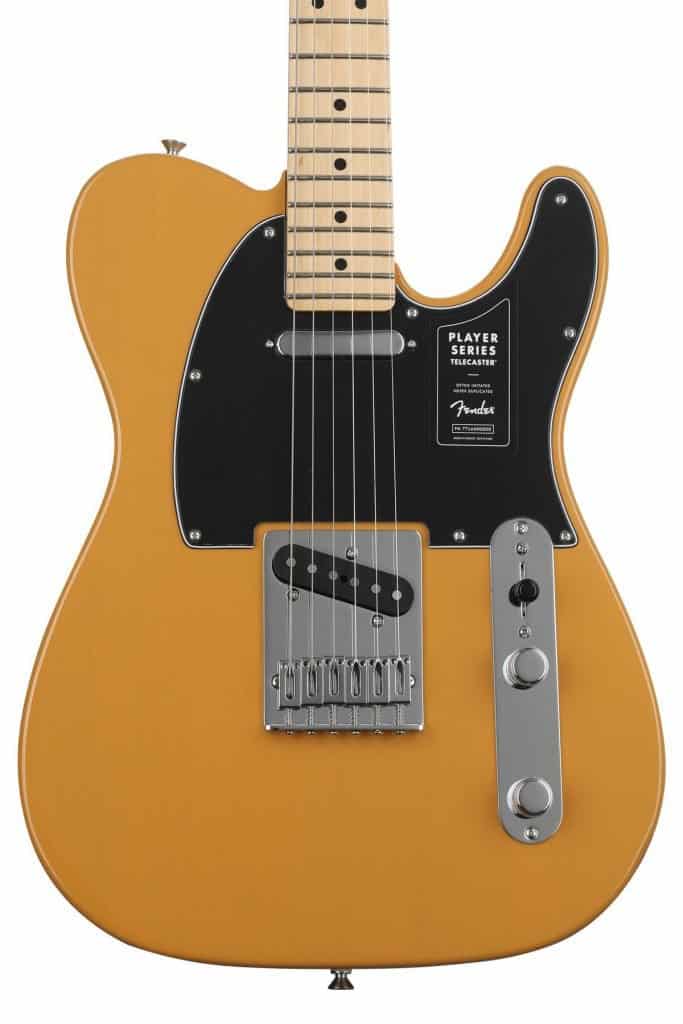
Ah, the classic butterscotch Tele. There’s a ton of history built into this player model that Fender Guitars has taken back to the drawing board. One of the first guitars to feature a maple fretboard as opposed to a rosewood fretboard. Leo Fender did it that way because, well, he didn’t know guitars weren’t supposed to have a maple fretboard. Now it’s part of the iconic snappy Tele sound.
While the appearance of the Player Telecaster has all the classic hallmarks of Fender’s past, the engineers made sure to update the electronics and build quality to one of the best modern guitars you will ever pick up.
The Alnico bridge position single coil has all the bright twang a Tele is known for, but crank that master volume, and she’ll take the lead as well. The thick bell tone of the neck position single coil is perfect for jazz leads or bass-heavy chords.
Of course, these single coil pickups, lovely as they are, won’t have you playing anything too heavy into the metalverse. But for classic rock, or just about anything that isn’t thrash speed, or death metal, you should feel confident in this guitar’s ability to get the job done.
- Classic, versatile twangy Fender tone.
- Maple fretboard is a bright-toned Leo Fender mistake.
- Not going to be able to produce those chunky metal tones.
Speaking of leads, the redesigned bridge pushes the sustain of this Player series well beyond any run-of-the-mill Telecaster. The team at Fender has also gone back with the entire Player series and altered the body radius to more historically accurate measurements.
What this means is that, when it comes to the Telecaster, the Player series is much more comfortable to play. It’s not as boxy around the edges, and you almost don’t miss having a contour cutaway.
Another little bit of fun, this is the model Fender based their new Tele Uke on. Classic butterscotch with black pickguard. Unfortunately, without the maple fretboard, but they’re still a ton of fun.
• • •
Epiphone Limited Edition 1959 Les Paul Standard – Best Starter Les Paul
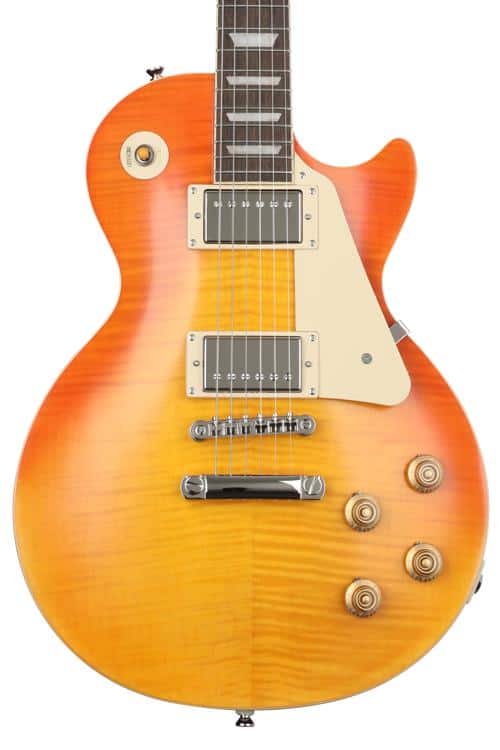
Gibson guitars make some of the most high-quality guitars in terms of performance and build on the market. The Les Paul guitars they’ve been cranking out for over half a century have to top that list. So, good luck getting something like a 1959 Gibson Les Paul for less than a thousand bucks. I mean, Gibson Les Paul and affordable guitars aren’t exactly synonymous.
However, Epiphone has come a long way in terms of build quality, tonal landscape, and all the features you’d expect from their much pricier siblings. Lucky for those of us intermediate players looking for a killer guitar without having to choose between a new guitar and the kid’s college fund.
The two humbucker pickups ensure this guitar sounds great. Why is that? Unlike the rest of the guitar, which is made overseas, the PAF Burstbucker pickups are genuine Gibson USA. Hence the limited edition status. A Tune-O-Matic bridge and genuine ‘59 C-shaped mahogany neck give this guitar a real Les Paul feel.
Can we talk about what that Tune-O-Matic bridge does for the action on this guitar? Once correctly set up, aside from the headstock shape, you won’t miss your Gibson Les Paul in the least. At least not at this price point.
- Proper reverence to the ‘59 Les Paul Classic
- Very approachable price point. Well under $1,000
- Genuine Gibson USA Burstbucker Humbuckers
- Made in China, so can occasionally be production line quality problems. Very rare, though.
The two volume and two tone controls give this Les Paul the vintage pre 60’s sound. Not too much gain, but just enough to make heavy rock rhythm-playing a reality. If you want to take the lead, the Indian Laurel fretboard sitting atop a mahogany neck is an absolute delight.
Honestly, if you’re not hung up on the “stigma” of playing an Epiphone Les Paul (and you shouldn’t be since the late 2010s), pick this one up. One of the best electric guitars I’ve had the pleasure of noodling with. Easily one of the best electrics under 1,000 dollars.
• • •
D’Angelico Premier Mini DC – Best Smaller Semi-Hollow Body Under $1,000

When you are ready to step away from the exclusive “Fender vs. Gibson” debate, you can find some of the best options under 1,000 dollars on the market. The D’Angelico is an excellent example of one of the best electric guitars not bearing one of the “big two’s” brands.
As its name suggests, the Premier Mini DC is laden with premium features that can go up against any Les Paul but with a diminutive size. The more petite laminated maple body and exotic ovangkol fretboard make this guitar supremely comfortable—a fantastic guitar for those players who might have smaller hands.
The Tune-O-Matic bridge and Rotomatic Stairstep tuners give the semi-hollow body a tremendous amount of sustain. Couple that with the Seymour Duncan pickups, and you end up with a solid guitar for just about any type of music short of the heaviest metal.
- Exotic fretboard is a joy to play.
- Tune-O-Matic bridge and stepped tuners make intonation among the best of any guitar.
- Aesthetic flourishes make you want to frame it.
- Probably not going to be your metal guitar.
D’Angelico is often pigeonholed into the jazz world, but the electronics on this guitar mean it will be right at home in the annals of rock, rockabilly, surf rock, or classic rock. Of course, you want to sound good in the studio, but the finishes on the Premier line will ensure you look good on stage as well.
The finishes jump off the instrument and cover the entire guitar, even the neck, which isn’t something you often see at this price point. The Skyscraper tuning pegs and truss rod cover are a nice aesthetic touch that sets this guitar apart visually. It lets you know it’s Premier before you even plug in.
• • •
Gretsch G5420TG-59 – Best Guitar Under $1,000 to Lead an Orchestra
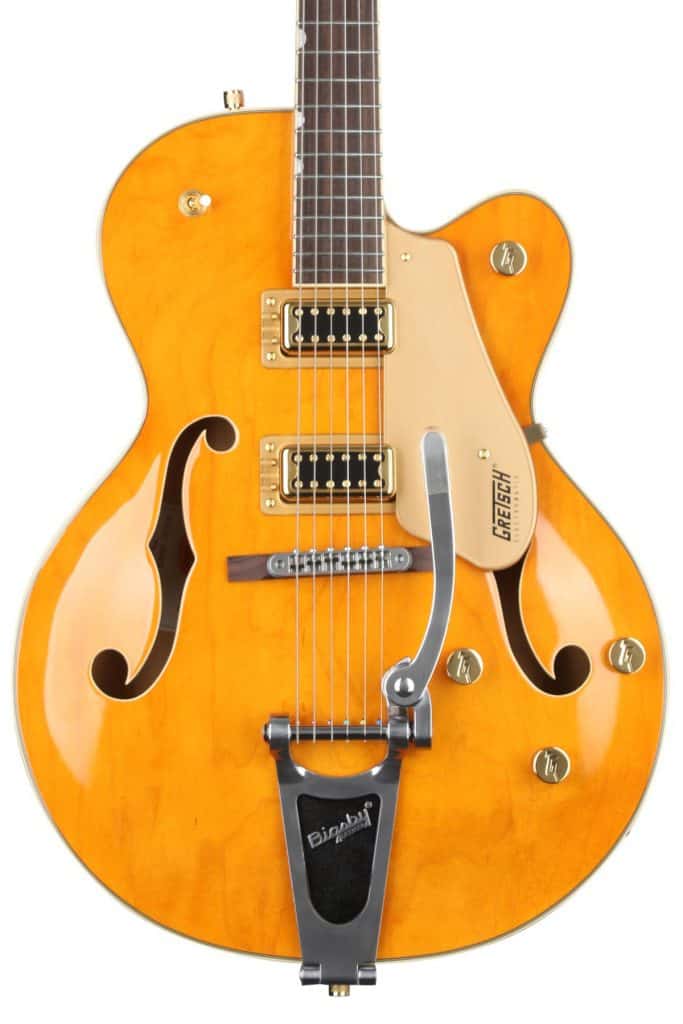
While we’re on the subject of hollow body art pieces, how about the Gretsch G5420TG-59? Sure, that is one hell of a naming scheme, but a hollowbody Gretsch electric guitar under $1,000? What planet are we on?
Now, granted, this may not be a Brian Setzer signature guitar, but it has a ton going for it that makes a Gretsch a Gretsch. A 5-ply maple body with an arched top and a rosewood fretboard that sits atop a maple neck. And in terms of inlays, the Gretsch Pearloid thumbnails on the otherwise naked fretboard tell you right away this is special.
There’s quite a bit going on with the electronics on this guitar. First off are the pickups. The G5420 features blacktop Filter’Tron humbucking pickups, reverse engineered from the gold standard in early rock pickups. They can emulate single coil pickups with their twang but also get riled up enough to drive authentic rock and roll.
- Classic Gretsch electric guitar features in an accessible price range.
- Unique finishes to stand out on stage.
- Bigsby bridge for endless bends.
- Electronics that rival any manufacturer.
- Metal need not apply.
- Your haircare budget may need a bump.
It gets that job done by giving the player a somewhat unusual collection of controls to dial in and tweak your pickups. There is a master volume, a master tone, and individual volume controls for each pickup. That means you can balance the volume of each pickup and use the master volume to crank the gain on the whole setup. Then use the master tone knob to further smooth everything out.
Now, would we be reviewing a Gretsch that wasn’t sporting a Bigsby bridge? Well, the G5420T delivers here as well. Meaning bends of single notes or entire chords are precisely what you’d expect from Gretsch.
They have managed to create one of the best guitars under 1,000 dollars and have their fingerprints all over it. There’s no mistaking what you’re getting here.
• • •
Yamaha Pacifica PAC612VIIFM – Best Well Rounded Yamaha, AKA Best Superstrat Under $1,000
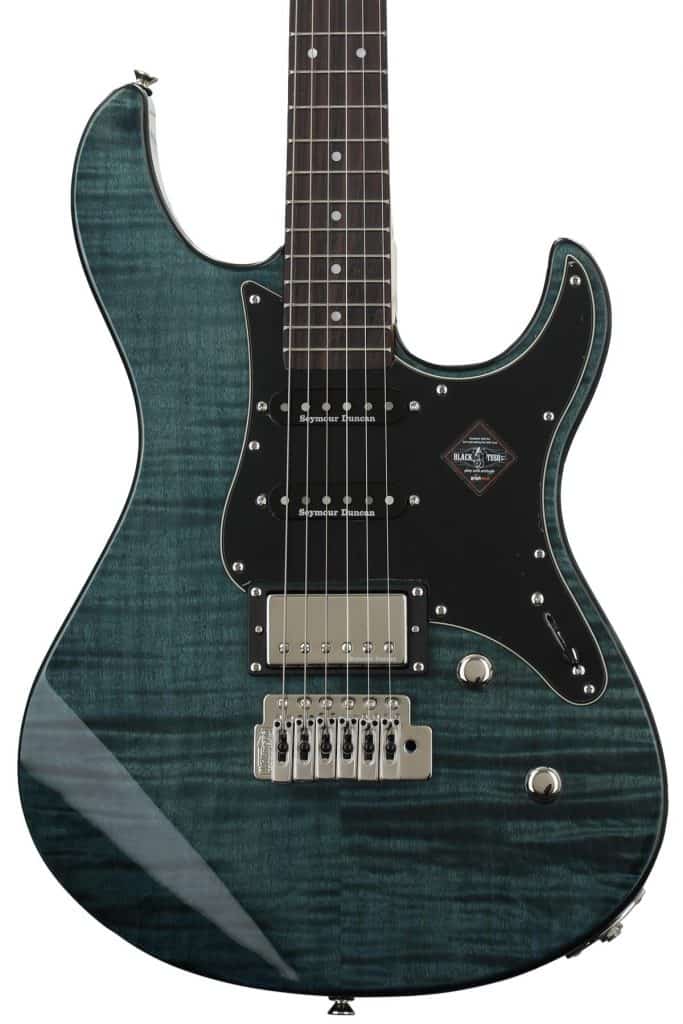
I may have mentioned this before, but Yamaha can get a bad rap around guitar purists because they’re a company that makes everything. But look at their logo… three tuning forks. And that’s stamped on their dirtbikes too, remember? So I think we can collectively give their musician bona fides a break. The Pacifica PAC612VIIFM is an excellent reason for allowing us to do that.
At first glance, it does have the feel of a Fender strat, but that’s just about where the similarities end at first glance. The C-shaped maple neck and rosewood fretboard make this a speedy guitar to play. Something metal guitars need… but we aren’t just looking at a metal guitar here.
The push-pull coil split feature means this Yamaha can crank the gain and dial it back to get classic strat tones out of its bevy of Seymour Duncan HSS pickups. There’s a lot of versatility in a humbucker that can double as a single coil pickup in the bridge position. Five-way switching with a master volume gives players a lot of options.
- Seymour Duncan Pickup array with push-pull coil split.
- Very attractive pricepoint for this list.
- An electric guitar with some real tonal versatility.
- Not everyone is going to be a fan of the bolt-on neck. Personal preference.
Like most electric guitars in the loosely “strat” lineage, the Pacifica solid body guitar features a bolt-on neck. You might want to see a set neck, but it’s a combination that’s been working for half a century, so why mix it up?
Our favorite options among the best axes under 1,000 bucks get the basics right and give players something that can play a variety of styles. A one-trick pony can be nice, but eventually, you get used to that trick. Variety is the spice of life, an unstated feature that the Yamaha nails.
• • •
Charvel Pro-Mod So-Cal Style 2 24 HT HH – Best Complex Tone Tele
If there were a “Telecaster on Steroids” award, it would go to the Charvel Pro-Mod So-Cal Style 2 24 HT HH.
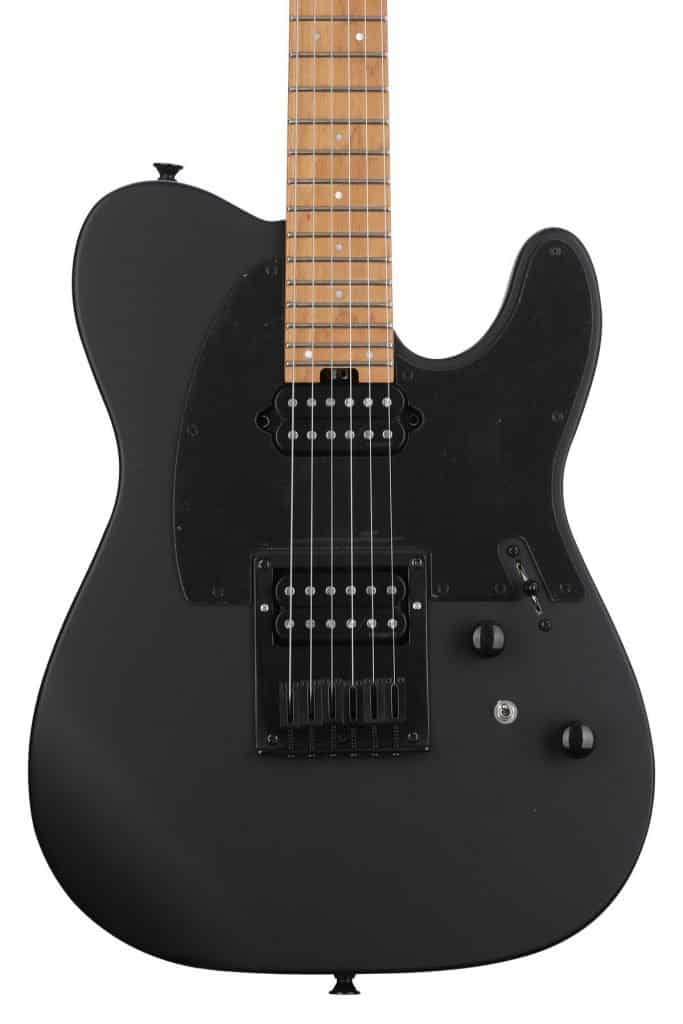
Fender owns Charvel. So it’s no surprise they pulled off a tremendous 21st-century version of an epic classic.
The guitar body’s curves are deeper than the classic Tele, making it more ergonomic.
It also features a scalloped lower back bout and cut heel. This helps access the upper fringes of the guitar’s 24-jumbo-fret, caramelized maple fretboard.
But what sets the Pro-Mod So-Cal Style 2 apart is its wide tonal range. This is due to its Fluence Open Core Classic pickups.
A two-way mini toggle switches the guitar’s pickups to “modern” and “vintage” voices.
- The guitar takes the versatility of the original Tele to a whole new level.
- Other cool features include:
- Charvel® HT6 string-through-body hardtail bridge with brass saddles, intended to boost sustain and intonation.
- Reverse licensed Fender® Telecaster® headstock. - Looks-wise, here are your options:
- Satin Black finish with black pickguard and black hardware.
- Snow White finish with parchment pickguard and chrome hardware.
- If you’re a less-is-more kind of musician, the guitar might have too many bells and whistles for your taste.
Here’s how the manufacturer describes these voices:
- When the mini toggle is down (“modern PAF”):

- The bridge pickup “delivers quintessential hot-rodded humbucking tone without all the baggage.”
- The neck pickup “delivers a Fluence-exclusive tone with clear and airy chime. Unbelievable high end, highly vocal midrange, and tight lows.”
- When the mini toggle is up (“vintage PAF”):
- The bridge pickup delivers “ideal vintage PAF humbucking tone calibrated for perfect output.”
- The neck pickup delivers “an ideal-but-elusive vintage PAF tone with just the right dynamics and output.”
A push/pull tone control splits the humbuckers into single coils.
Add a three-way blade pickup switch, and the tonal combinations are infinite.
Overwhelmed? Pull up the tone control. Put the switchblade in position 2. Now you’re back to the classic Tele configuration — outer single coils in the bridge and neck.
• • •
PRS SE Custom 24 – Best Value In Electric Guitar World
The PRS SE Custom 24 is quite similar to its more expensive, elder sibling — the legendary PRS Custom 24.
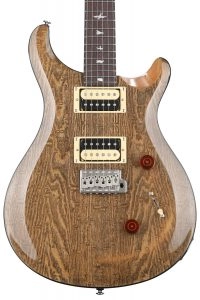
The “SE” in PRS’s SE line stands for “Student Edition.” It’s made in South Korea, whereas the original Custom 24 is made in the USA.
It features the same mahogany body as the PRS SE Custom 24. The key difference in body construction boils down to the maple top.
The Custom 24 features a one-piece flamed maple top. The SE Custom has a thick maple top covered with a flamed maple veneer.
This detail means the PRS SE Custom 24 saves you a ton of money without sacrificing tonal quality.
Both guitars feature 24-fret rosewood fretboards with gorgeous bird inlays. The SE Custom has a maple neck, whereas the Custom 24 has a mahogany neck.
- This is an incredibly high-quality, beautiful, and versatile guitar. It’s almost like buying a genuine, American-made
- PRS Custom-24 for a third of the price.
- Other cool features include:
Available in a wide variety of gorgeous finishes. My favorites are Charcoal Burst, Fire Red Burst, and Sapphire.
- Some customers think that the guitar’s tone is a bit too bright when in single-coil mode.
Two 85/15 “S” pickups coupled with a 3-way blade pickup selector boost the SE Custom’s tonal versatility. Also, a push/pull tone control allows you to turn both humbucking pickups into single coils.
The SE Custom comes with a custom-designed, floating PRS bridge. But you can also get it with a double-locking, Floyd Rose 1000 Series Tremolo.
• • •
PRS SE Silver Sky – Best Value in Wonderland
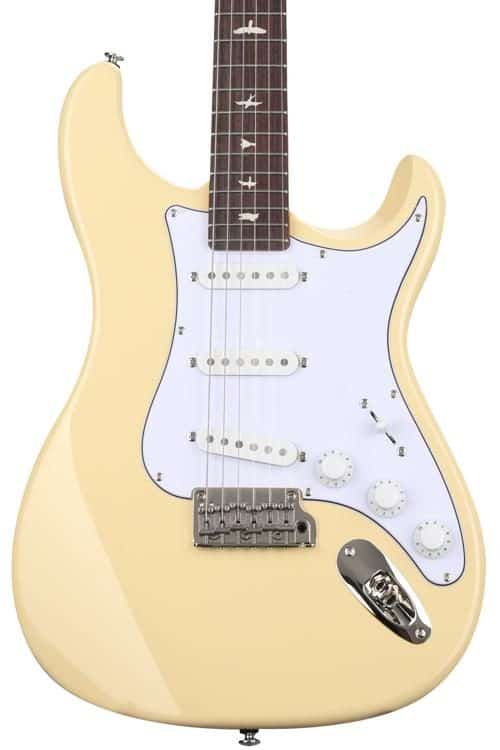
John Mayer is known for playing vintage Fender Stratocaster electric guitars with your basic five-way switch, two tone knobs, a single volume control, and three single coil pickups. That’s the man’s setup. At least until he teamed up with PRS to make that setup with their legendary quality control.
The result was the Custom Silver Sky collaboration. Now, Mayer may not be your particular cup of tea, but as electric guitars go, you’d be hard-pressed to say it isn’t a work of art.
Okay, visually, aside from the lack of inline tuners and headstock shape, it is a Strat for all intents and purposes. But one of the best guitar players in the world spent time doing a custom shop job, resulting in electric guitars under 1,000 bucks that rival the Fender Custom Shop series. The customer reviews speak for themselves. If you’re a Fender Strat player who just hasn’t quite got it to click no matter which model you’ve played, this could be it.
- Might be the most comfortable Strat-style guitar on the market.
- Noiseless Pickups are absolutely perfect for single coils.
- Student Editions do not sacrifice quality.
- John Mayer… ugh. Really? I guess. Way to go… John.
The pickups really stand out on this guitar. Glassy without being shrill but can be cranked with enough gain to rock out. That’s really what you want out of your single coils.
The neck has been tweaked ever so slightly to reflect John’s input, and it might be the best electric guitar I’ve fretted. Obviously, the bird inlays on the rosewood fingerboard stand out.
I’m not a fan of the aesthetic of PRS (they play like a dream, though), usually, but if I could get the best Strat electric guitar under $1,000? Now that it’s not only available as a Mayer custom model, and has made it to the SE series? Hoo boy. That’s a tempting proposition.
• • •
ESP LTD EC-1000 QM – best Top Notch Shredder
It’s fair to say that the guitars reviewed so far are suitable for metal. But they’re primarily rock/blues/jazz instruments.

Well, the ESP LTD EC-1000 QM is primarily a metal guitar. But it’s also fair to say it’s suitable for rock/blues/jazz.
This difference mainly boils down to the guitar’s pickups. The ESP LTD EC-1000 QM features EMG 60 and EMG 81 humbucking pickups.
The EC-1000 QM is made in South Korea. Its look and feel balance a classic Les-Paul vibe with a 21-st century post-modern edginess.
The guitar has a mahogany body and a quilted maple top with a colorful, psychedelic finish.
The super sharp cutaway also contributes to the aesthetic effect. It also lets you reach down to the 24th of its extra-jumbo frets with ease.
- The guitar strikes a great balance between vintage looks and modern technology and sound.
- It’s a versatile instrument, but perhaps better suited for rock and metal than for blues, jazz, or pop.
The ESP LTD EC-1000 QM boasts a Tonepros locking TOM bridge/tailpiece. There’s also the option of getting it with a Floyd Rose double-locking tremolo.
The ESP LTD EC-1000 is basically the same guitar. But it features two passive Seymour Duncan pickups with push-pull coil-splits. (At the time of writing, this guitar was available for $999 on Sweetwater. It might be more than $1,000 at the time you’re reading this. You can double-check the guitar’s price here).
Here’s a demo of the ESP LTD EC-1000:
• • •
Schecter Hellraiser C-1 – For The Sophisticated Shredder
There are some similarities between the Schecter Hellraiser C-1 and the ESP LTD EC-1000:

Both guitars are manufactured in South Korea.
Both are versatile guitars. But both were designed with the metal guitarist in mind.
Both guitars have a mahogany body with a quilted maple top.
Both guitars have 24 frets.
Like the ESP LTD EC-1000 QM, the Schecter Hellraiser C-1 packs two active EMG pickups.
However, the Hellraiser’s EMG’s are different from the EC-1000’s: an EMG 81TW at the bridge with an EMG 89 at the neck.
The EMG 81TW dual-mode design combines an EMG 81 humbucker and a separate single-coil pickup in the same housing.
This is different from having a pair of coils with one turning on and off. The master tone push/pull control transforms the bridge humbucker into a single-coil.
- It’s one of the very best guitars for metal shredders of all kinds.
- Despite its versatility, the guitar is more suitable for rock and metal than for blues, jazz, or pop.
The EMG 89 humbucker at the neck uses Alnico V magnets. And it has separate preamps and coils, which allows you to split it into two single coils.
A three-way switchblade also adds to the guitar’s vast tonal range.
A TonePros TOM bridge with through-body construction boosts the guitar’s resonance and sustain.
You can also get the Hellraiser C-1 with a Floyd Rose tremolo system. (Be aware that at the time of writing, this feature takes the guitar price to $999 on Sweetwater. By the time you read this article, it might have surpassed the $1,000-mark.)
• • •
Ibanez RGA42HPT – Classiest Ibanez Around
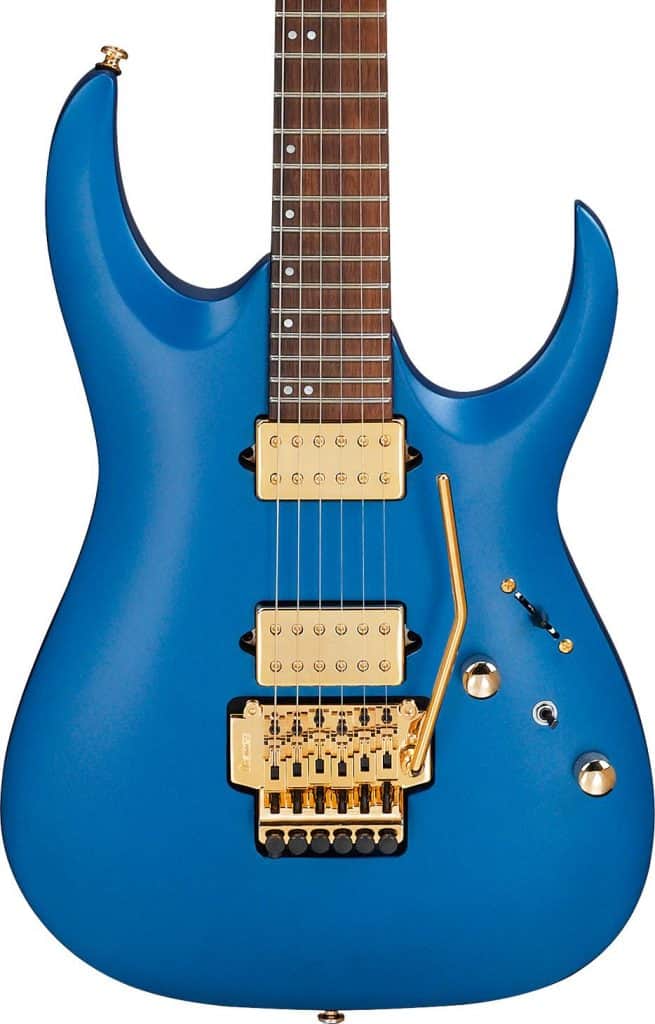
Ibanez launched the RGA42HPT in 2020. It’s made in Indonesia, and the latest addition to its legendary RGA series.
The guitar has a sculpted Nyatoh body bolted to a roasted maple neck.
Its 24-fret jatoba fingerboard features offset dot position markers. The luminescent side dots are a blessing on stage when the lighting is scarce.
It features two direct-mounted, gold-hardware DiMarzio Fusion Edge humbucking pickups. They’re manufactured only for Ibanez guitars.
Last but not least, the RGA42HPT sports a double-locking tremolo bridge.
- The guitar is as suitable for rock as any of the legendary RGA Series. But sound- and looks-wise it’s also perfect for blues, jazz, and even pop, if you ask me.
- It’s available only in Laser Blue Mate with golden pickups, tremolo and locking nut. I personally love this color combination, but it might not be for everyone.
This is an axe made with the metal shredder in mind. However, its coil-split toggle and 5-position switchblade increase the guitar’s tonal range.
Check out a demo and detailed rundown of the guitar’s features in the following video:
• • •
Ibanez Genesis Collection RG550 – Best Guitar Under $1,000 that Talks Dirty to Me

Where is Doc Brown in Spandex when you need him? We’re going back to 1987 with this reissue of one of the most popular metal guitars of all time.
Why was it so popular? Well, you have to consider how much discretionary income you had back then. When living on the Sunset Strip in Hollywood, you must consider the best electric guitars that won’t interfere with your drug habit. Financially… you’re going off the rails man. Come on.
Enter the Ibanez Genesis Collection. A reissue of electric guitars under $1,000 that will keep you in whatever vices you’re a fan of. While shredding some of the most iconic riffs written on an Aquanet high.
Seriously though, the Genesis in desert sun yellow is a work of art. It’s downright hard to stare directly at it. A maple fretboard, simple tone controls, two screaming humbuckers with a center single coil, and matching headstock finish gave this electric guitar so much attitude you had to dress like CC Deville just to keep pace.
- Reissue of one of the most iconic metal guitars of all time.
- Eye-popping finishes.
- Wizard-shaped neck for the fastest fretboard in the west.
- This is only for metal and the hardest of rock.
- Do they still make Aquanet?
An edge-locking tremolo setup with Gotoh tuners gave way to some of the enormous bends of the era because you know you’re staying in tune. A maple neck mixed with walnut provides the guitar with a unique look, a bit of an upgrade, and a build that you haven’t seen much of before. That maple neck also improved the stability of the overall instrument. This is metal, after all.
What more can you ask for in your electric guitar built for metal? A rosewood fingerboard? Or a mahogany fretboard? I suppose. But it’s a reissue. We can’t change the past. Remember what happened when Biff did that with all that sports betting? Oof.
• • •
EVH 5150 Series Standard – Eddie’s Workhorse
What a better way to leave your newbie days behind than adopting the legendary Van Halen brown sound?

With the EVH 5150 Series Standard, you can do just that for less than $1,000.
The guitar is a re-edition of the striped 5150 series guitar. It’s made in Mexico.
The guitar’s famous predecessor had only a bridge humbucker. And just like the guitar God’s original axe, a single volume control.
The 5150 Standard breaks with that minimalistic configuration in two important ways.
First, it features two custom-designed, direct-mounted EVH Wolfgang Alnico 2 humbuckers, instead of one.
According to the manufacturer, the bridge humbucker, “delivers the perfect amount of punch and articulation with sweet sustain and thick chunky rhythms in a perfectly balanced EQ curve.”
- A guitar that pretty much delivers Eddie’s legendary Brown Sound at a reasonable price.
- Other cool features include:
- Truss rod adjustment wheel placed at the heel of the neck. This allows easy neck relief tweaks without tearing your guitar apart.
- The guitar comes in three beautiful, non-striped finishes. Many people think striped looks great on Eddie, but not on everyone.
- The guitar has a basswood body. Some people think this is a low-quality wood. (But in my opinion, if it’s good for Eddie, it’s good for anyone!)

And the neck humbucker “serves up no-nonsense, balls to the wall overdrive and endless sustain without skimping on articulate cleans when the volume is rolled down.”
The guitar is also equipped with a high-friction tone knob. This is in addition to the low-friction volume knob, designed to emulate Eddie’s majestic volume swellings.
A three-way toggle engages the bridge humbucker in position one for brown-sound riffing. Position two engages both pickups, while position three puts the spotlight on the neck humbucker for Eruption-like soloing.
The quartersawn, 22-jumbo-fret maple neck features a modified “C” profile. It’s less wide and more rounded at the nut than towards the heel. This is intended for more comfortable riffing and chording at the nut and easier bending near the heel.
The guitar sports a “dive-bomb” certified EVH-branded top-mount Floyd Rose tremolo system. And a d-tuner allows you to easily switch back and forth from drop-D to standard tuning.
Here’s a full demo of the 5150 Standard by the great Cameron Cooper:
• • •
Epiphone Noel Gallagher Riviera — Best Appointed Full-Size Semi-hollow
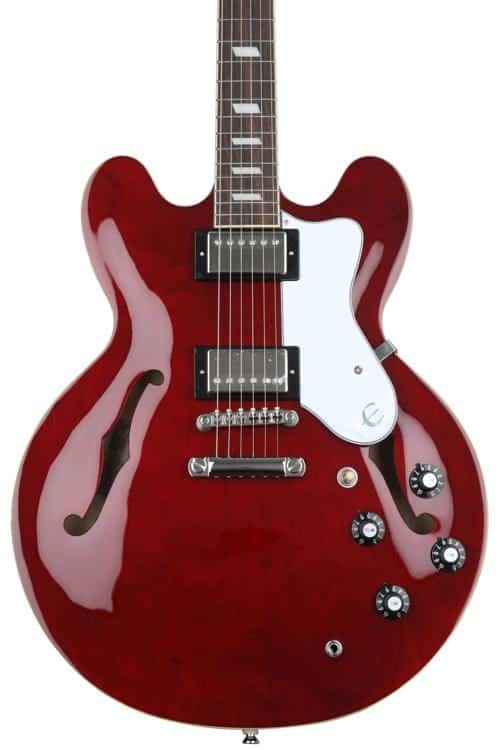
Noel Gallagher is one of the greatest songwriters of his generation. That’s hard to argue with, and he played some of the best electric guitars of that generation. His Epiphone Sharatton with its Union Jack finish during much of his touring career with Oasis is a legendary and iconic instrument.
Suffice it to say, the relationship between Noel and Epiphone has been one of the closest over the past 40 years.
Well, they’re back at it, producing one of the best electric guitars under 1,000. And, yes, you guessed it, it’s a semi-hollow body. Noel’s staple style. This may be the best electric this partnership has turned out.
- Getting that pure Oasis tone for the first time in ages.
- Getting that tone at an affordable price.
- The equal-wound Alnico pickups are spectacular at this price point.
- Wish it came in the Union Jack finish.
Two Alnico humbuckers sit in front of Epiphone’s Tune-O-Matic bridge, ensuring signal consistency and familiarity with that late 90s Brit Pop movement. The guitar neck is a slim C style, and the 3-piece maple construction gives it comfortable action.
This is just a gorgeous piece of nostalgia and goes head to head with Les Paul guitars in a similar price range. If you’re a fan of the 90s invasion, specifically of that epic Oasis sound, this Riviera is worth your attention.
• • •
Sterling By Music Man Mariposa — Best Combination of Action and Styling under 1,000
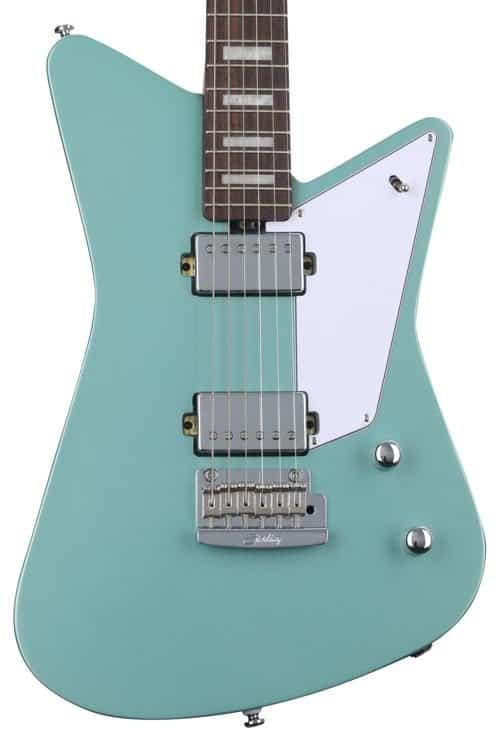
The year is 1999, and there are four of us walking through Guitar Center in San Diego when it caught my eye. A Music Man guitar. I’d never seen one. Of course, I’d been relegated to bass, so I was well aware of the Sterling bass guitars with their single massive humbucking pickup, but I had no idea about the guitars.
Was I in for a surprise. These three-floor models had, by far, the lowest and fastest action I’d ever played on a six-string. Fast forward some 25 years, and Sterling by Music Man is still cranking out some of the best-playing guitars on the planet.
The Mariposa model is a mid-level priced axe with aggressive styling. I love the signature Ernie Ball model from St. Vincent, but there’s no way I’m going to drop two weeks’ rent on a guitar I’m not willing to put a scratch on.
- Modern offset styling looks like nothing else.
- Superb Music Man action is perfect for the fastest playing.
- Rock, Metal, Alternative… Each style a good fit.
- It’d be nice to have at least a gig bag included.
- Lack of tone control is going to turn some off.
The Mariposa is another story. It’s beautiful, sure, but having been designed by Omar Rodriguez-Lopez from At the Drive-In, this thing is built to rock on another level. The custom, in-house designed humbuckers offer excellent mid-range tone, and the guitar features individual volume knobs. No tone controls because when you’re rocking that hard, why muddy the waters?
As a kid, a guitar like this may have seemed out of reach, but given inflation, the fact I’m an adult… yeah, I think I’ve rationalized my way into adding this to my collection. I suggest you do the same. Post haste.
• • •
My Personal Favorite
All the guitars reviewed in this article are high-quality instruments.
They all deliver excellent value for money.
I guess the final choice depends on personal preference more than anything else.
If your budget allows, perhaps you should consider buying more than one of these excellent guitars.
However, if you can’t allow yourself to spend more than $1,000, then you’ll have to boil it down to one.
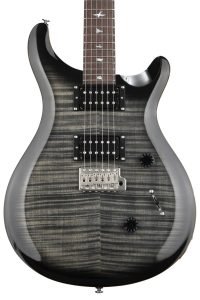
And if I had to recommend one guitar out of the ten, that’d be the PRS SE Custom 24.
I have tried this guitar many times. And I can’t find a noticeable difference in sound compared to the real-deal PRS Custom 24… which costs almost five times as much!
It’s a super versatile instrument, suitable for almost any music style. And its aesthetics are equally adaptable. Its darker finishes, like the Charcoal Burst, will look great on stage whether you play in a metal, hard rock, blues, jazz, or pop band.
In other words, if you asked me what’s the best intermediate electric guitar out there, I’d say it’s the PRS SE Custom 24.
Actually, let me rephrase that. This gem of a guitar is a great candidate for the best electric guitar for the money in the market today. Period.
• • •
Electric Guitars Under $1,000 – Buying Guide
Now, if you talk to your wife, husband, significant other, or mother, you may get some pushback on buying an electric guitar that is the equivalent of a downpayment on a car. Is that guitar going to take you places? Absolutely… but metaphorically, not physically.
So if you’re going to justify dropping something close to a grand on any instrument, you need to do a little self-reflection and a lot of research. Perhaps, unfortunately, you’re going to need to crack a psychology book.
Here’s how you get started.
• • •
Should you Spend Close to $1,000 on a Guitar?
Well, now, that’s a loaded question, isn’t it?

The short answer to this question is, “yes, if you can afford it.”
In my opinion, the most critical factor to consider here is the stage you’re at on your journey as a guitarist.
At this point, you’ve probably spent a year or two honing your skills on a cheaper guitar.
Now you’re more of an intermediate player than a beginner. And you’re able to appreciate how your sound improves with the quality of your instrument. This is especially true for fingerstyle playing.
You also have a much better idea of how to match a high-quality guitar with the right gear to optimize its tone.
Improving your sound will further boost your motivation to continue practicing.
• • •
The Benefits of Spending Around $1,000 On Your First Guitar
I always say that beginners should start playing with a cheap guitar. Even in the long run, electric guitars under 1,000 dollars shouldn’t break the bank. If they are, you need to talk to your accountant, post haste.
After all, If you’re willing to put in the time and effort, you can even get a very decent sound out of an old, used guitar.
That way, you don’t risk too much money until you know for sure that you can commit to learning to play.
However, starting with a more expensive guitar also has clear advantages:
- The better the quality of your guitar, the more comfortable it’ll be to play it and to progress on it as a beginner.
- The better sound quality will boost your motivation to practice, even if your ear isn’t very sharp yet.
• • •
A Guitar For A Lifetime
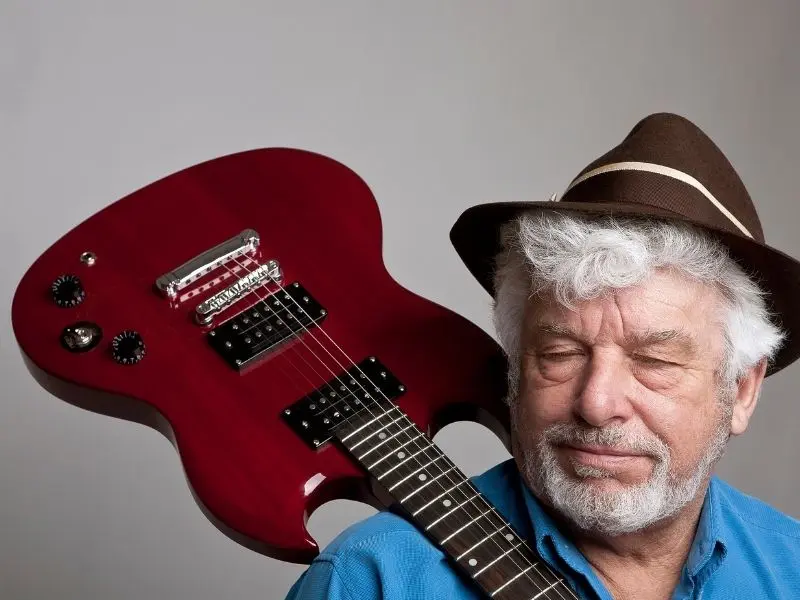
But perhaps the most important advantage of buying a guitar for close to $1,000 is that you’ll be able to keep it for life.
You can always upgrade the pickups or otherwise tweak any of the guitars we’ll review in this article. This will allow you to enjoy playing them even if you become a professional guitar player.
After all, many pros use guitars in this price range as their backup axe. They take them to club gigs when they worry their more expensive guitars could get damaged or stolen.
Is this Guitar a One-Trick Pony?
Now that you’ve decided that you’re going to move forward with a guitar that’s going to last you a lifetime, it’s time to go shopping. This is where the self-reflection comes in.
According to a recent study, most of us stop listening to new music around age 33 and experience something known as “taste lock.” (1). You may be unique. Still, it’s important to consider your age and tastes when shopping for electric guitars under $1,000.
The Case for a Youngin’

If you’re younger and someone buys this for you, your tastes may not yet be solidified. In that sense, you’ll want a guitar that can provide more variety. That is, at home in different styles. You may look back in ten years and realize what terrible taste you had in black metal, and really, folk revival is more your scene. Now, what are you going to do with that ESP?
Get yourself a nice well-rounded Les Paul.
The Case for the Curmudgeon Set in Their Ways
On the other hand, if you’re in your 40s (like me, so don’t eviscerate me in the comments) and metal is your jam, then a really aggressive rig that only feels at home cranked up to eleven may suit you just fine.
That taste lock is a documented phenomenon, so don’t gloss over it. Anticipate it. Work with it. We’re only human.
• • •
Buying Three Guitars Instead of One
Of course, this is not for everyone.
But let’s say you’ve reached a point where you’re sure that playing the guitar is something you want to do long term.
Then you should consider buying three guitars instead of one.
In particular, owning the Strat/Tele/Les Paul trifecta can take your playing to a whole new level. And this applies to both the stage and the studio.
Here’s a video that explains this in detail:
• • •
What To Do Next
Don’t have close to $1,000 to spend on a guitar? Check out our article on the best beginner electric guitar packages. If you want to start polishing your tone beyond the basic settings of your amp, read our guide to the must-have guitar pedals. Perhaps you want to consider complementing your new electric with an acoustic that doesn’t break the bank. And if metal is definitely your thing, you might benefit from reading our ESP guitars review article.
• • •
References
- Music Machinery, “Exploring age-specific preferences in listening,” as published here https://musicmachinery.com/2014/02/13/age-specific-listening/

